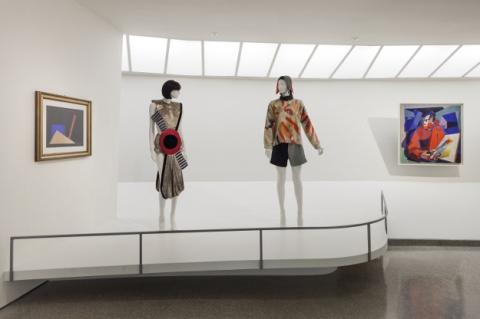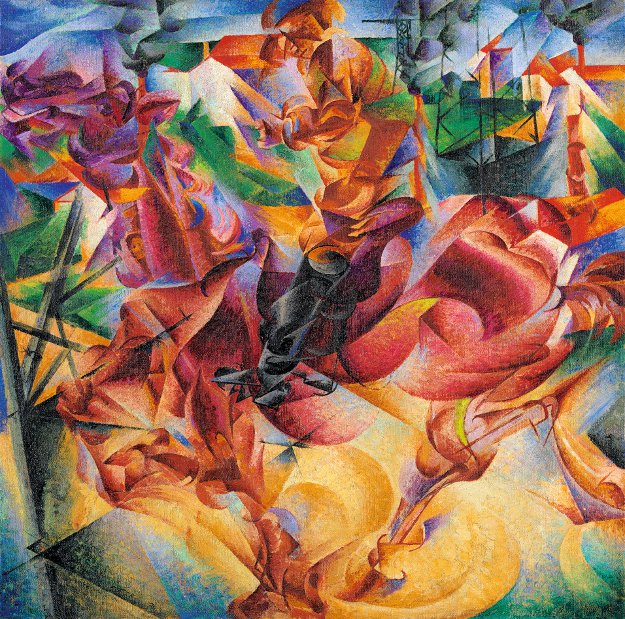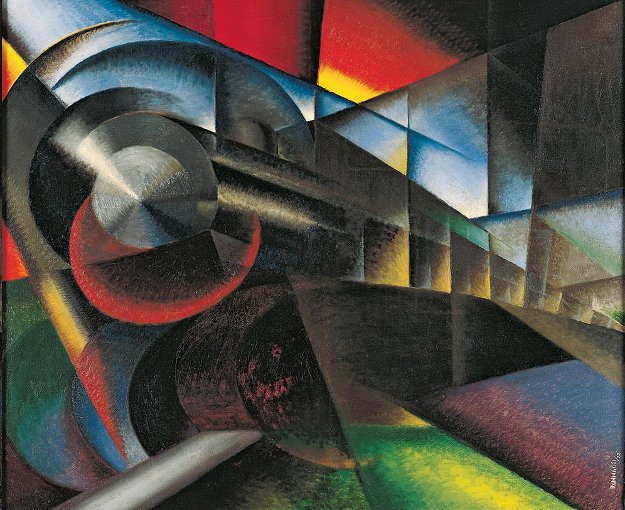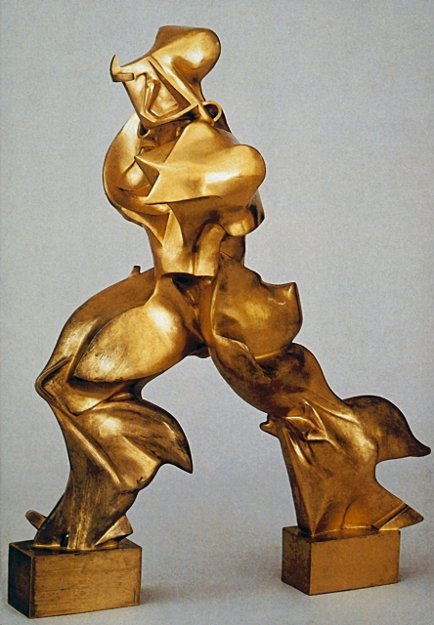Invasion of the Italian Futurists

Judging by their 1909 manifesto, the Italian Futurists were a violent lot. They called for nothing less than the destruction of museums, libraries and feminism. They intended to “glorify war, the only hygiene of the world,” and to “sing to the love of danger.” If their manifestos fell a little flat, their creative endeavors were all-encompassing, reconstructing painting, sculpture, architecture, fashion and even performance to such an extent that we would never look at the world in quite the same way again.
Visitors of all ages to the Guggenheim Museum will have the opportunity to see how far-reaching the Futurists’ impact was—Italian Futurism, 1909-1944: Reconstructing the Universe is surely one of the most ambitious shows the museum has ever attempted. Over 300 works executed between 1909 and 1944 are on display, and it’s a dizzying climb up the ramps through the movement’s 35-year history—from Umberto Boccioni’s magnificent abstract bronze humanoid-on-the-run (Unique Forms of Continuity in Space) from 1913 on the ground floor rotunda to Tullio Crali’s 1939 death-defying aerialist depicted in his painting Before the Parachute Opens, we are catapulted into another dimension.
Nothing stands still in this exhibition. After all, in F.T. Marinetti’s revolutionary manifesto (only one of many on display in the various cases stationed throughout or plastered in giant font size to the walls), “the beauty of speed” is everything. According to museum director Richard Armstrong in the accompanying 352-page catalogue, the first generation of Futurists rejected stasis, “aspiring to break with the existing notions of space and time to place the viewer at the center of the artwork.”

It’s a serendipitous state of affairs, obviously not lost on Senior Curator Vivien Greene, that the site for this vertigo-inducing exhibit is none other than the Guggenheim’s own spiraling headquarters—Frank Lloyd Wright’s otherworldly repository for art that seems to have emerged full-blown from the architect’s own futuristic dream.
The cataclysmic changes in the culture, brought on by the train, the car, the advent of the aeroplane—the urbanized metropolis dancing to a new beat—had a lightning impact on a key group, including the likes of F.T. Marinetti, Umberto Boccioni, Carlo Carra, Gino Severini, and Giacomo Balla, among others. If the Italians were the driving force, they were followed closely behind by the Russian contingent, such as Natalia Goncharova, Velimir Khlebnikov, and Vladimir Mayakovsky. If velocity was the prevailing force, Balla understood that light was the fastest element in the universe, and the refraction of light in a streetlamp (Lampada at Arco) is an early painting that demonstrates how such a splintered prism can become a powerful example of a two-dimensional subject exploding on the viewer.
Perhaps the highlight of Balla’s experimentations is his Abstract Speed + Sound from 1913-14, a whirlwind of dynamic intersecting lines and color. So enamored with his role as one of the first signers of the manifesto, Balla even named his own daughter Elica—that’s Italian for propeller.

However, the Futurists were not content to live in a goldfish bowl of their own devising. Severini was insistent that his compatriots visit him in Paris to see for themselves the advances of Cubism. As Severini was quoted in Richard Friedenthal’s “Letters of the Great Artists,” “…the Cubists’ method of grasping an object is to go round and round it; the Futurists declared that one had to get inside it.” Certainly, with a little imagination, the simultaneity of Balla’s The Hand of the Violinist (The Rhythm of the Bow) manages to put us inside the reverberations of the instrument itself. It’s a beautifully rendered painting and brings to mind nothing less than Marcel Duchamp’s own Nude Descending A Staircase.
Boccioni’s The City Rises (1911) and Elasticity (1912) show his mastery with the brush, the manipulation of color and line as impressive as his sculptural experimentations. In the former, it’s as if a great fissure had opened up. Figures of labor leap from the flames and a red horse’s head rearing up in the foreground, reminiscent of Picasso’s hypnotic steed from Guernica, his paean to the ravages of war. Elasticity is a turbulent work that achieves its power from the churning abstract vortex of color and shape alone.
There’s a small show of photographic stills, but whatever interest the Futurists showed in photodynamics appears to have been more an intellectual enterprise—a worthy one, but here it can hardly compete with the unbridled passion and majesty of their early paintings.

Documentary filmmaker Jen Sachs was commissioned by the museum to combine an enlivening mix of archival footage, printed matter, declamations and musical compositions in three separate installations. These help to break up the vast chronological scope of the show. There is so much to focus upon that these mise-en-scene installations, particularly a performance sampling, The Opera d’Arte Totale, of Stravinsky’s Fireworks—with rays of changing light bouncing off the annex walls—are a refreshing breather before plunging back into other multidisciplinary exhibits.
If the Futurists celebrated war in their bombastic rhetoric, it played havoc with the life of one of its brightest stars. Boccioni’s nationalistic fervor led him to an early enlistment in World War I, where he was quickly trampled to death after falling from his horse. His breathtaking figure in motion mentioned earlier, Unique Forms of Continuity in Space—some have compared it to the Louvre’s graceful Nike of Samothrace, from 190 B.C. — was not cast in bronze until 1949. It now appears on Italian 20 cent euro coins.
Another unfortunate casualty was the architect Antonio Sant’Elia, whose drawings for The New City never saw fruition in the real world, but his ideas influenced later urban architects for their clean lines and simplicity. Lucky for the movement’s own survival, many other talents were spared. Severini painted several war paintings, e.g. Red Cross Train Passing a Village, once again exhibiting his mastery of color with bold oranges, purples, chartreuses and reds to dazzle the eye, but it’s in the placement of shapes that we feel ourselves within feet of the locomotive’s energy. Ivo Pannaggi’s Speeding Train (1922) is just as riveting, threatening to collide directly with the viewer’s perspective.

If the movement never quite regained the ferocious beauty of its heroic stage, its versatility in a broad implementation of its aims is admirable. During and after the war, Balla designed clothing and house wares—an octagonal-shaped coffee service, along with his sketches in watercolor and ink are worth a look. Fortunato Depero’s lighthearted approach to everything from toys to tapestries is everywhere evident. Four natty waistcoats by the artist are worth a close-up look and a lineup of his wooden toy rhinos and Little White Devils (Dance of Devils) tapestry are delightful additions. His greatest fame, however, rested in his Campari logos, and here we get a fair sampling of those designs with their signature little bon vivant. It was Depero who was prescient enough to declare “The art of the future will be the art of advertising.”
This comprehensive glimpse of the Futurists and their world would not be complete without an examination of their Aeropainting (aeropittura). The second generation, beginning in 1926, embraced flight as the perfect way to synthesize their focus on dynamism and a nationalistic pride in war propaganda. Marinetti had seen aerial battles in action as a war correspondent during the Battle of Tripoli in 1911 and a chief proponent of this new movement was Marinetti’s own wife, Benedetta (Cappa Marinetti). Her Synthesis of Aerial Communications is a gorgeous evocation of flight in tones of cerulean blue, giving it a feeling of weightlessness in spite of its bold geometric rendering. It is one of five monumental pieces commissioned by the Palazzo delle Poste (Post Office) in Palermo, Sicily. These works are more than worth the trip to the top gallery annexes and are truly a majestic sight to behold. Marinetti’s key role in composing the initial Futurist manifesto, that included “scorn of women” as one of its declarations, obviously did little to deter this woman from promoting her own vision.
There is much to focus upon in this broad-reaching presentation. And it’s important to remember that the intense nationalistic fervor that led to an alliance with Benito Mussolini and his National Fascist Party in the movement’s later period would serve to obscure the forceful impact these artists made on the culture at large. Even though modern art was more tolerated and even supported by the Fascists—unlike Hitler’s early denouncements of such art in Germany as “degenerate”—the party’s right-wing members would eventually follow suit and condemn much of Futurism’s works.
It is to the credit of Ms. Greene’s efforts and an international committee of eminent scholars that we are given the first truly stunning overview of this vital 20th century avant-garde movement.

The exhibit, Italian Futurism, Reconstructing the Universe, 1909-1944, will be on view at the Solomon R. Guggenheim Museum and Foundation, 1071 Fifth avenue, New York, NY 10128-0173, 212-423-3840 until September 1, 2014.
Author Bio:
Sandra Bertrand is Highbrow Magazine’s chief art critic.































































































































































































































































































































